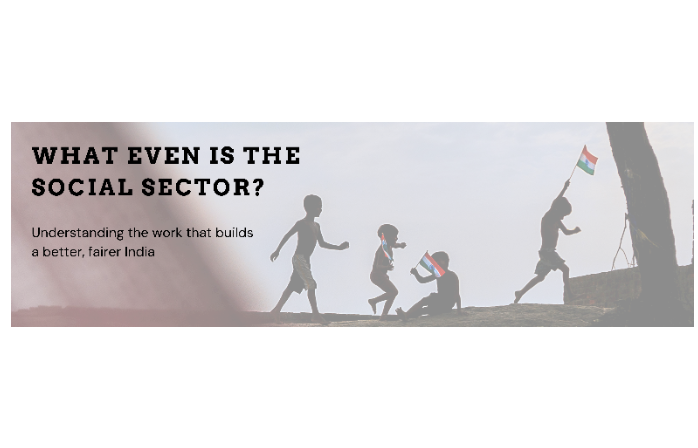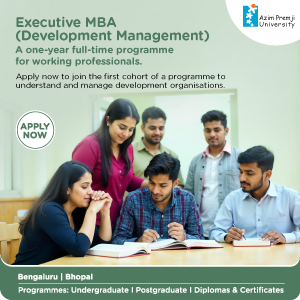What Even Is the Social Sector?
August 19, 2025

NGOBOX
What Even Is the Social Sector?
Understanding the work that builds a better, fairer India
We hear the term “social sector” quite often. It finds its place in news headlines, annual reports, even in conversations with donors or development professionals. But when asked what it really means, we often find ourselves scrambling for the right words.
Is it about NGOs? Is it about volunteering? Is it only about rural development? The answer is - none of these fully, and yet, all of them in parts.
The social sector is not a neatly boxed category. It is, in fact, a wide ecosystem of people, institutions, and efforts that work to solve social and developmental problems. These could be problems that the government systems haven’t fully addressed, or challenges that need new, people-driven solutions. The social sector is all around us. We may not always see it, but it is always at work.
What kind of work does the social sector do?The social sector works on issues that affect large sections of society, particularly the underserved. This includes work in areas like education, nutrition, public health, climate change, livelihood generation, gender equity, disability inclusion, tribal development, and disaster relief. Some of the work involves direct service delivery - running schools, setting up primary healthcare centres, or conducting skilling programs. Some of it focuses on enabling access to public entitlements. Others may work in research, policy advocacy, or building platforms that connect communities to government schemes.
The social sector includes people who are listening, building, advocating, funding, and enabling change every day.
Who are the people and organisations behind this work?The sector includes a range of actors like non-profits, grassroots organisations, social enterprises, philanthropic foundations, corporate CSR arms, and government systems.
Non-government and Non-profit organisations (NGOs/NPOs) are the most visible players. Some work on specific themes, while others are deeply rooted in geographies. For instance, Sunbird Trust works in remote, conflict-affected regions of Northeast India, focusing on building peace through education. They offer scholarships, build schools and hostels, and invest in long-term partnerships with communities and the Indian Army.
Community-Based Organisations (CBOs) are locally formed collectives, such as women’s self-help groups or farmer cooperatives. These are people solving their own problems using context-specific solutions.
Social Enterprises operate at the intersection of profit and purpose. One well-known example is SELCO India, which provides solar-powered solutions to underserved communities empowering schools, health centres, and small enterprises with clean energy access.
Philanthropic Foundations play a catalytic role in funding innovative ideas and enabling scale. For example, the Azim Premji Foundation not only funds grassroots education initiatives across India, but also runs its own programs, partners with state governments, and supports research and policy work in education and equity.
Corporate CSR Arms are now integral to the ecosystem. For instance, Infosys Foundation supports education, rural development, and healthcare, while also funding infrastructure in underserved areas. Under India’s CSR mandate, many companies now actively support impactful programs across the country.
Each of these players contributes in different ways, helping bridge gaps that are not fully addressed by markets or the government.
How is the social sector funded?The government remains the largest funder, contributing over 95% of the total social spending through its schemes. Programs such as MGNREGA, PM-POSHAN (formerly Mid-Day Meal Scheme), and the National Health Mission serve as large-scale public efforts. However, private and philanthropic funding, though smaller in size, plays a critical role in innovation, last-mile delivery, and strengthening community-led responses. These include:
The strength of the Indian social sector lies in its layered funding approach—public money for scale, private funding for innovation and adaptability.
Decoding the Common TermsIf you’re new to the development space, you’re likely to come across a few terms that sound complex. But they’re actually quite easy to understand when explained simply.
Because it shows up where others don’t.
During the COVID-19 pandemic, we saw thousands of organisations, small and large - pivot overnight to support people with food, medicine, transport, and information. These weren’t systems designed for emergencies. They were networks built on trust, local knowledge, and years of being rooted in the field. But this is not just a sector of emergencies. It’s a sector of everyday action. Whether it’s ensuring children get midday meals, helping young girls stay in school, protecting the rights of sanitation workers, or making cities more accessible for persons with disabilities, the social sector works quietly and consistently. It complements government efforts, reaches the last mile, and builds systems that work for everyone - not just for those at the centre.
In ConclusionThe social sector is not one entity but it is a vast, living, learning ecosystem. It includes people who research, people who implement, people who fund, and people who simply show up.
To understand the social sector is to recognise the invisible work that makes visible change. And perhaps, to ask yourself, where do I fit in?
Source

Shanmukha Priya Chadarada is a professional social worker with over seven years of experience in the development sector, working across child development, education, and community-led initiatives. A gold medalist with a Master’s in Social Work from Amrita University and a Bachelor’s in Business Management, she brings together people-centric insight and managerial perspective. She currently works in the fundraising and donor engagement vertical of a leading NGO, while also freelancing as a writer and designer - passionate about making development conversations clear, creative and widely accessible.
© Renalysis Consultants Pvt Ltd














